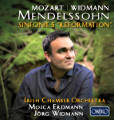ORFEO International – Reviews
Important Releases Briefly Introduced
March 2017
Mozart | Widmann | Mendelssohn
The second instalment of Jörg Widmann’s involvement with the Irish Chamber Orchestra and their recordings of Felix Mendelssohn’s symphonies is devoted to what is known as the composer’s Fifth, in keeping with the upcoming celebrations to mark 500 years since the Reformation. In fact, from a chronological point of view, this is Mendelssohn’s second symphony. 
C 921 171 Conceived originall, to mark the celebrations of 300 years since the Reformation’s “Augsburg Confession” of 1530, to play the work and the premiere never took place – a shocking experience for the then-23- the premiere planned for 1832 seemed to be very promising, since the work was to be played by the benchmark orchestra of the day, the Orchestra of the Paris Conservatoire under the baton of François-Antoine Habeneck. However, rehearsals descended into tumult, the orchestra refused year-old former child prodigy. The following year the gifted composer applied, after the death of his mentor Carl Friedrich Zelter, to succeed him as Director of the Berlin Singakademie. Mendelssohn was eminently qualified for the post and was encouraged by many friends to apply, in view of his groundbreaking revival of Bach’s St Matthew Passion with that choral society just four years earlier. As part of his application Mendelssohn had given three concerts, one of which included the premiere of his “Symphony in Celebration of the Church Revolution”. The fact that his application was unsuccessful was traumatic for the young composer, whose approach to faith was an idealistic one. The rejection was bound up for him with his second great attempt at a symphony and he wanted nothing more to do with the work thereafter; indeed, it was not published until 1868, more than 20 years after his death, by his son Paul under the posthumous opus number 107.
Today’s verdict on the work’s musical status is of course an entirely different matter. The reports by Mendelssohn’s friend Ferdinand Hiller about the failed rehearsals in Paris – “the work is altogether too scholastic [...] too many fugatos, too little melody and much more in that vein” – say more from today’s standpoint about the composer than about the overburdened orchestra musicians. And in this era when we are almost obsessively torn between overcoming and reawakening national, cultural and religious identities, Mendelssohn’s complex and (not merely) aesthetic experiment undertaken at a time poised between revolution and restoration is truly fascinating – especially when one adds in the extra dimension of the historical allusion to the Reformation. The daring and abundantly formal characteristics of the work offer more than ample material for such analysis, from the confrontation of the artistic, canonically-elaborated Catholic intonation of the Psalms employing a Reformational wind chorale over the “Dresden Amen” that both Wagner and Bruckner were to use, through to the superimposition of the sonata writing and chorale variation in the final movement.
For someone like Jörg Widmann, so intimately familiar with the technical and aesthetic dimensions of the art of composition, it was an appealing challenge to contrast the historically fraught and consciously complex experiment by the mature prodigy Mendelssohn with the young Mozart’s highly emotional, compositionally concentrated answer to his encounter with Bach’s Fugues, which Baron von Swieten had introduced him to in the 1780s in Vienna: the Fugue in C Minor for two pianos, expanded here by a passionate Adagio and arranged here for string orchestra.
The first recording of an adaptation of Widmann’s own String Quartet No. 5 (with soprano) takes the same formation and decisively expands it with an oboe and two bassoons in his “Attempt at a Fugue” from 2005, which he believes is probably his most serious piece in the tradition of Haydn’s and Mozart’s “scholarly”, “artificial” fugal quartets, and which both reflects and deconstructs the history of this genre.
Finally, the instrumentalist, conductor and composer Widmann has fulfilled a personal wish and a promise to the orchestra and all clarinetists and listeners to arrange for clarinet and piano one of his favourite pieces by the 15-year-old Mendelssohn: the Andante from the Sonata in E flat major of 1824, and to perform it with the orchestra, for the first time, in his version for clarinet, string orchestra, harp and celesta to produce – according to the arranger himself –“miracle music”.
top |